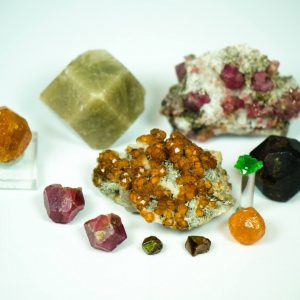In crystallography, Garnet is the name given to a group of silicate minerals that share the same isomorphic (cubic) structure and general chemical formula. They are found all over the world in types of foliated metamorphosed rock called schist and gneiss. Garnet can also grow on an igneous and occasionally sedimentary rock.
Formation occurs under intense pressure at high temperatures. The extreme conditions are responsible for the hardness and durability the little G’s are so admired for. This makes them ideal for jewelry smithing and industrial use. Pyrope, almandine, spessartine, grossular, uvarovite, and andradite are the six most common varieties of Garnet although rarer varieties do exist.

Garnets are regarded highly for their diversity of color, affordability, and abundance. When identifying a Garnet specimen it is helpful to think in terms of color, the most abundant of the colors being red, followed by orange, green, yellow, brown and black. These six colors are generally less expensive compared to rarer garnets.
The name garnet is said to have come from the Latin word granatus meaning “grain”. Some make reference to the pomegranate fruit which has a red seeds similar to garnet minerals in a rock cluster. Others believe that the name garnet stems from the Middle English word gernet meaning “dark-red”.

For centuries, Garnets have been set in ornamental jewelry. Garnet beads, necklaces and gems have been found in burial sites dating back to the Bronze age and in the tombs of mummified Pharaohs in Ancient Egypt. These discoveries give us insight into the history of humankind’s relationship with garnet as spiritually, emotionally and physically significant.
Beyond ritual adornment, garnets have maintained popularity for ages because of their abrasiveness. They have a hardness range from 6 to 7.5 on the Mohs scale. Commercial uses of garnet include sandpaper, water filtration, abrasive blasting media, and abrasive powders. Other industries such as motor, aircraft, glass, petroleum, and textile manufacturers are also consuming garnet for industrial use.
Since ancient times the healers, shamans, spiritualists and metaphysically minded people have understood that crystals and gemstones hold the energy of the Earth. Many believe that the energy of these once living organisms can be used as a tool for strengthening spirit, ascending vibration and healing ailments. Others believe crystal therapy and metaphysics to be pseudoscience.
Crystals are created by living organisms and are made up of tiny molecules and atoms. They can be interacted with similarly to humans. For example, if you approach a crystal with bad or negative intention you will, in turn, have a negative experience. If you approach a crystal with an open mind and heart then you will have your intention reflected back to you, tenfold.
Garnets possess both positive and negative energies that can be projected, received and deflected. These energetic circuits or channels have the ability to increase the integrity of our auric field depending on its frequency and our perception.

Crystal healing is an alternative medicine with unique results for every practitioner. I find it important to emphasize that physical, spiritual and emotional healing properties of crystals are learned from personal reports and experiences.
It would be without credibility for me to speak on garnets definite spiritual and physical healing properties. My personal belief is that every individual will form a unique connection with a specimen depending on their own perception of it.
Garnets kaleidoscope of color offerings, durability and affordability make it one of the most cherished and popular mineral groups. I encourage you to experience garnet through your own perception and channel its healing potential through your own energy fields.









